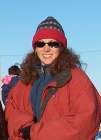 |
|
|
| Author |
Message |
Misty_Nikula-Ohlsen

Joined: 23 Mar 2004
Posts: 74
Location: Barrow, AK

|
 Posted:
Fri Jul 30, 2004 5:00 am Posted:
Fri Jul 30, 2004 5:00 am |
  |
We woke this morning to continuing pleasant weather. Still sunny and warm, so we set out to BEO after breakfast without thermals and I even dared short sleeves (with a long sleeved shirt tied around my waist, just in case). It was the nicest walk to BEO that we had had all summer. No mosquitoes, sunny weather, a refreshing breeze. Except for the lack of trees and the constant mud, we could have forgotten that we were in the Arctic.
After our trek to BEO, where we flawlessly downloaded the data, we drove to CMDL, where we also flawlessly downloaded more data  , and then went to lunch, our work completed for the day. While we were at lunch, Dora came and told us that Anne Jensen, a local archeologist, who works for the Ukpeagvik Inupiat Corportation, was going to be going out to Point Barrow to continue the excavation of a gravesite. Over 500 years ago, there was a small village at the very northern edge of the Point called Nuvuk and up to 50 years ago, people still lived there. However, severe erosion of the gravel there has washed away much of the site. Over the past 100 years, nearly a mile or so of beach has been washed away, according to some local recollections. On the edge of the bluff that is still present, some human remains have been found that are beginning to “fall” out of the bank as it continues to erode. Anne is responsible for excavating the remains, documenting them and then they are reburied in the Inupiat cemetery south of town. , and then went to lunch, our work completed for the day. While we were at lunch, Dora came and told us that Anne Jensen, a local archeologist, who works for the Ukpeagvik Inupiat Corportation, was going to be going out to Point Barrow to continue the excavation of a gravesite. Over 500 years ago, there was a small village at the very northern edge of the Point called Nuvuk and up to 50 years ago, people still lived there. However, severe erosion of the gravel there has washed away much of the site. Over the past 100 years, nearly a mile or so of beach has been washed away, according to some local recollections. On the edge of the bluff that is still present, some human remains have been found that are beginning to “fall” out of the bank as it continues to erode. Anne is responsible for excavating the remains, documenting them and then they are reburied in the Inupiat cemetery south of town.
So we got on several layers to combat the wind and Anne, Dora, Kim, Henry and I set out on four-wheelers. Much to our surprise and joy, when we got to the northwest corner of the Point, there were several grey whales feeding on krill and small fish just off the shore. We cautiously walked up to the edge of the beach and watched them feeding (and took copious pictures and video) for about half an hour. It was amazing! One small whale just kept swimming toward the beach with its mouth open, skimming the water for krill (small shrimp-like creatures). When it got about 15-20 feet from the shore, it turned around and swam back, again with its mouth open.

Our friendly whale
The shoreline was covered with tiny gelatinous, pink krill. Just piled up by the waves.

Krill on the beach
We could also see dozens of gulls feeding farther offshore and the water was teeming with tiny fish. There were so many of them jumping about at the top of the water that it looked like a heavy rain.

Fish jumping
We were in complete awe and could have sat on the beach watching the whales, gulls and fish for hours, but we had work to do.
We continued down the beach to the excavation site.

Our excavation location
The first thing that we needed to do was to set up the Theodolite, which is a surveying sort of instrument that allows archeologists like Anne to precisely mark the artifacts, bones, graves and other object that they locate while they are digging.

Theodolite
To mark the exact location of an object in a digging site, you need two other precisely-determined markers. These two locations are first used to “calibrate” the Theodolite. The Theodolite is set up directly over top of one of the markers and a mirrored prism on a 1.5 m pole is held over the second one.

Prism
Then the instrument shoots an infrared beam at the prism and measures the time it takes to come back. By knowing how fast the beam travels (the speed of light) it can determine the distance to the prism. Since the two reference locations are programmed into the instrument, it uses this information to determine the direction that it is pointing and uses this as a starting point to determine the direction that it is pointing when an actual measurement is taken. When an object is collected, the Theodolite measures its precise UTM location (by knowing its location, what direction it is pointing and the distance to the object) and a slip of paper is printed out and placed with the object inside a collection bag.
After the Thedolite was set up, we were ready to begin excavating. Anne thought that we would need to remove about 1 meter or so of sod and top soil, so we started to remove the thick sod with trowels. All of the sod that we removed was put onto a tarp to be sifted and sorted later, in case there were other artifacts or bones hidden within it

Removing sod
Once we had removed the sod, we began to carefully uncover the previously exposed bones. Human bones are much less resilient to weathering and exposure than animal bones and become very spongy and fragile. Once Anne got a good look at the already exposed bones, we discovered that they were not laid out in any sort of anatomical orientation, but rather were just in a big pile. Anne guessed that these bones had most likely been dug up and reburied at some point in the past, perhaps by people looking for artifacts or even perhaps at a later date after burial for some unknown religious or cultural reason.
As we carefully removed pieces of the overhanging sod and gravel with our trowels, we collected the material into large dust pans (so it would not fall down the slope) and we sifted through it looking for bits of bone or wood and then emptied the dust pans onto the tarp. We continued to find more pieces of vertebra, skull bones and other bones that I could not identify. We also found pieces of fossil ivory, caribou horn and other work implements. All of the artifacts that did not belong to the skeleton, we placed into collection bags that were labeled with the location, the contents and the excavator (Anne) to be sorted later in the lab.
Dora, Kim and Anne stayed to continue excavating, while Henry took me back so I could make it to dinner by about 6 pm, since Kirstin and I had planned to see Joe’s Museum that evening. The others ended up staying at the site until nearly 9:30 pm.
After dinner, Kirstin and I went to Pepe’s Restaurant to see if we could find Joe to give us a tour of his museum. We had heard from Marcus and Heather that it was a Barrow “must see”.
Joe’s Museum was nothing short of unique and VERY Barrow. After Joe tied up his two dogs (named My Dog and My Other Dog, as he told us), we were treated to a truly overwhelming, but amazing tour nonetheless. Joe’s Museum is in the front room and kitchen of Joe’s house and admission is by donation. It is hard to describe Joe’s Museum . . . crowded is one word.
Joe has the most amazing collection of stuffed animals (polar bear, brown bear, black bear, bobcat, elk, wolves, weasels, wolverines, mush ox), artifacts (bits of very old tools made of wood, ivory, bone and baleen, ancient mukluks and baskets, bone or stone knives and ulus (Eskimo knives)), fossils (mammoth teeth and tusks, walrus ivory, musk ox horns, teeth of just about every animal that lived on the North Slope) and preserved animal parts (walrus skulls, caribou horns, whale bones and eardrums, seal bones, pelts and hooves). There are hundreds of objects crammed into display cases and every nook and cranny of his small apartment living room. In addition, to all of the Eskimo artifacts and animal parts, Joe has a tremendous number of pictures of animals, old soda cans, contemporary artistic ivory, horn or bone carvings and painted or crafted baleen and his own impressive collection of Beatles memorabilia. As he takes you through the museum, he frenetically tells you story after story about the pieces and their history or origin, all punctuated by jokes. Joe has been in Barrow for about 20 years now and I don’t think that he has EVER thrown a thing away. Marcus and Heather were right; Joe’s Museum was definitely a “must-see” attraction in Barrow. While pictures cannot do it justice, I have placed a few into the photo album.

Joe’s front room |
|
|
     |
 |
|
|
|
View next topic
View previous topic
You cannot post new topics in this forum
You cannot reply to topics in this forum
You cannot edit your posts in this forum
You cannot delete your posts in this forum
You cannot vote in polls in this forum
You cannot attach files in this forum
You can download files in this forum
|
Powered by phpBB 2.0.11
© 2001, 2002 phpBB Group :: FI Theme ::
All times are GMT
| |
